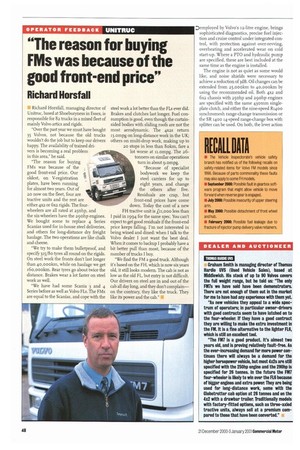"The reason for buying FMs was because of the good front-end price"
Page 50

Page 51

If you've noticed an error in this article please click here to report it so we can fix it.
Richard Horsfall
Richard Horsfall, managing director of Unitruc, based at Shoeburyness in Essex, is responsible for 82 trucks in a mixed fleet of mainly Volvo artics and rigids.
"Over the past year we must have bought 35 Volvos, not because the old trucks wouldn't do the job but to keep our drivers happy. The availability of trained dri vers is becoming a real problem in this area," he said.
"The reason for buying FMs was because of the good front-end price. Our oldest, on V-registration plates, have been running for almost two years. Out of zo now on the fleet, four are tractive units and the rest are either 4x2 or 6x2 rigids. The fourwheelers are all rated at 250hp, and the six-wheelers have the 29ohp engines. We bought some to replace 4 Series Scanias used for in-house steel deliveries, and others for long-distance dry freight haulage. The two operations are like chalk and cheese.
"We try to make them bulletproof, and specify 315/80 tyres all round On the rigids. On steel work the fronts don't last longer than 4 o,000km, while on haulage we get tho,000lcm. Rear tyres go about twice the distance. Brakes wear a lot faster on steel work as well.
"We have had some Scania 3 and 4 Series before as well as Volvo FLs. The FMs are equal to the Scanias, and cope with the steel work a lot better than the FLs ever did. Brakes and clutches last longer. Fuel consumption is good, even though the curtainsided bodies with sliding roofs are not the most aerodynamic. The 4x2s return 13.0mpg on long-distance work in the UK; others on multi-drop work, making up to zo stops in less than 8olcm, fare a lot worse at mompg. The 26tonners on similar operations turn in about 9.ompg.
"Because of specialist bodywork we keep the steel carriers for up to eight years, and change the others after five. Residuals are crap, but front-end prices have come down. Today the cost of a new
FH tractive unit is Li, ,00o less than I paid in 1994 for the same spec. You can't expect to get good residuals if the front-end price keeps falling. I'm not interested in being wined and dined: when I talk to the Volvo dealer I just want the best deal. When it comes to backup I probably have a bit better pull than most, because of the number of trucks I buy.
"We find the FM a good truck. Although it's based on the FH, which is now six years old, it still looks modem, The cab is not as low as the old FL but entry is not difficult. Our drivers on steel are in and out of the cab all day long, and they don't complain— on the contrary, they like the truck. They like its power and the cab."
Demployed by Volvo's 12-Iitre engine, brings sophisticated diagnostics, precise fuel injection and cruise control under integrated control, with protection against over-revving, overheating and accelerated wear on cold start-up. Where a PTO and hydraulic pump are specified, these are best included at the same time as the engine is installed.
The engine is not as quiet as some would like, and noise shields were necessary to achieve a reduction of 3dB. Oil changes can be extended from 25,000km to 40,000lun by using the recommended oil. Both 4x2 and 6x2 chassis with 250hp and 29olip engines are specified with the same 43omm singleplate clutch, and either the nine-speed Ri400 synchromesh range-change transmission or the SR 1400 14-speed range-change box with splitter can be used. On both, the lever action is said to be 30% lighter than on previous models, and clutch effort has been reduced by about 30%. Drive is continued through to Volvo's new compact light and efficient RS1344SV single reduction axle. In the past single reduction axles needed a large crown wheel contained in an even larger bell housing to handle the imposed loads. Volvo's single reduction gear incorporates a hypoid final drive gear, offset in relation to the crown wheel to spread the load over several teeth in mesh at any one time. Other features include a three-bearing pinion, case-hardened gears, induction-hardened drive shafts and a wellproportioned differential lock. The axle includes sealed-for-life wheel bearings, and sealed-for-life CV joints are incorporated in the propshaft.
The i8-tonner comes with rear air suspension as standard. Electronic control can be used to adjust to docking heights, and two common heights can be programmed into a memory. This is aimed primarily at body demount operations. The 6x2 also comes with rear air suspension and a lifting tag axle. The ABS bralcing system controlling drum brakes front and rear is supplemented by a powerful exhaust brake rated at 105kW (r4ohp) at 2,600rpm. Disc brakes should appear next year, on the front axle at least, but they require a change to the wheel dish which could prove a problem in fleets where wheels and tyres are moved between vehides.
byllillrock








































































































































